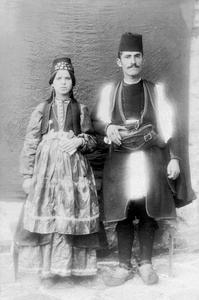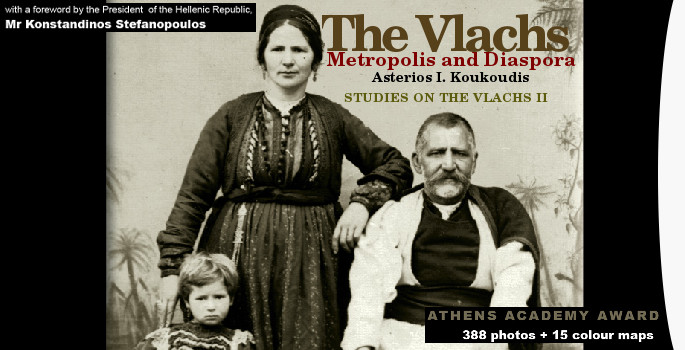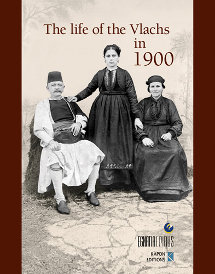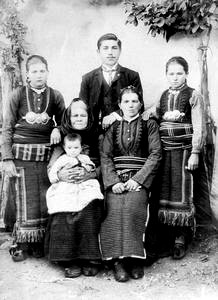THE VLACHS: METROPOLIS AND DIASPORA
III. The Vlachs of the Northern Pindos: The Vlach villages in the Grevena area
1.3. The Kupatshari
 Apart from the known Vlach villages, there is another distinct group of villages in the Grevena area which are of great interest with regard to the former extent of the Vlach settlements. These are the villages of the Kupatshari. Although most of them seem to have been Greek-speaking for many generations, some writers have presented them as having once been Vlach villages or villages with a partially Vlach population, which was gradually assimilated and disappeared together with the Vlach language. Most of the Kupatshar villages lie to the west of Grevena and their names are: Doxaras (Boura), Kyrakli, Elatos (Divrani), Kastro, Anavryta (Vrastino), Kalirahi (Vravonista), Aëtia (Tsouriakas), Messolouri, Prosvoro (Delno or Delvino), Alatopetra (Touzi), Dotsiko (Dousko), Filipaii (Filkli, Firkli), Polyneri (Vodensko), Panorama (Sarganaii, Siarganli), Lavda, Perivolaki (Lipinitsa), Ziakas (Tista), Spilaio, Trikomo (Zalovo), Paroria (Riahovo), Stavros (Paliohori), Kosmati (Kousmatsli in Vlach), Sitaras (Sitovo), Mavranaii (Mavranle), Mavronoros, Kipourio (Tsipourie), Lagadia (Zapado, Zapadaii), Mikrolivado (Labanitsa), and Monahiti (Mounahitlou).[1] It must be noted that the extent and the number of the Kupatshar villages cannot be estimated with any degree of accuracy. They must also include villages to the north and south of Grevena, such as Kalamitsi, Messolakkos (Zgosti), Kalohi, Eleftherohori, Felli, Despotis (Skhinovo), Pigaditsa, Aimilianos (Grindades), Melissi (Plessia), Ayii Theodori, Sitaras, Diakos (Libinovo), and Anthrakia.[2]
Apart from the known Vlach villages, there is another distinct group of villages in the Grevena area which are of great interest with regard to the former extent of the Vlach settlements. These are the villages of the Kupatshari. Although most of them seem to have been Greek-speaking for many generations, some writers have presented them as having once been Vlach villages or villages with a partially Vlach population, which was gradually assimilated and disappeared together with the Vlach language. Most of the Kupatshar villages lie to the west of Grevena and their names are: Doxaras (Boura), Kyrakli, Elatos (Divrani), Kastro, Anavryta (Vrastino), Kalirahi (Vravonista), Aëtia (Tsouriakas), Messolouri, Prosvoro (Delno or Delvino), Alatopetra (Touzi), Dotsiko (Dousko), Filipaii (Filkli, Firkli), Polyneri (Vodensko), Panorama (Sarganaii, Siarganli), Lavda, Perivolaki (Lipinitsa), Ziakas (Tista), Spilaio, Trikomo (Zalovo), Paroria (Riahovo), Stavros (Paliohori), Kosmati (Kousmatsli in Vlach), Sitaras (Sitovo), Mavranaii (Mavranle), Mavronoros, Kipourio (Tsipourie), Lagadia (Zapado, Zapadaii), Mikrolivado (Labanitsa), and Monahiti (Mounahitlou).[1] It must be noted that the extent and the number of the Kupatshar villages cannot be estimated with any degree of accuracy. They must also include villages to the north and south of Grevena, such as Kalamitsi, Messolakkos (Zgosti), Kalohi, Eleftherohori, Felli, Despotis (Skhinovo), Pigaditsa, Aimilianos (Grindades), Melissi (Plessia), Ayii Theodori, Sitaras, Diakos (Libinovo), and Anthrakia.[2]
In the mid-seventeenth century, the inhabitants of many of the villages in the upper Aliakmon valley ― in the areas of Grevena, Anaselitsa or Voio, and Kastoria ― gradually converted to Islam. Among them were a number of Kupatshari, who continued to speak Greek, however, and to observe many of their old Christian customs. The Islamicised Greek-speaking inhabitants of these areas came to be better known as ‘Valaades’. They were also called ‘Foutsides’, while to the Vlachs of the Grevena area they were also known as ‘Vlahoutsi’. According to Greek statistics, in 1923 Anavryta (Vrastino), Kastro, Kyrakali, and Pigaditsa were inhabited exclusively by Moslems (i.e. Valaades), while Elatos (Divrani), Doxaras (Boura), Kalamitsi, Felli, and Melissi (Plessia) were inhabited by Moslem Valaades and Christian Kupatshari. There were also Valaades living in Grevena, as also in other villages to the north and east of the town.[3] It should be noted that the term ‘Valaades’ refers to the Greek-speaking Moslems not only of the Grevena area but also of Anaselitsa. In 1924, despite even their own objections, the last of the Valaades, being Moslems, were forced to leave Greece under the terms of the compulsory exchange of populations between Greece and Turkey. Until then they had been almost entirely Greek-speakers. Many of the descendants of the Valaades of Anaselitsa, now scattered through Turkey and particularly Eastern Thrace (in such towns as Kumburgaz, Büyükçekmece, and Catalca), still speak the Greek dialect of Western Macedonia, which, significantly, they themselves call roumeïka ‘the language of the Romii’.[4] It is worth noting the recent research carried out by Kemal Yalçin, which puts a human face on the fate of 120 or so families from Anavryta and Kastro, who were involved in the exchange of populations. They set sail from Thessaloniki for Izmir, and from there settled en bloc in the village of Honaz near Denizli.[5]
The Kupatshar villages were rather poor farming and pastoral settlements with very few inhabitants, at least in comparison with the nearby Vlach villages; though by the mid-nineteenth century some of them were already practising transhumance after the manner of the Vlach villages.[6] The villages of Dotsiko and Messolouri near Samarina are now deserted in winter, because their inhabitants have adopted a semi-nomadic lifestyle. One of the predominant theories about the etymology of the name ‘Kupatshari’ is that it comes from the Vlach word koupatsiou, which means ‘oak tree’, and specifically the little shoots that grow around the bole. So they may have been called ‘Kupatshari’ because they lived in an area that was once forested with oaks. Weigand, however, asserts that the origin of the name is more probably the Slavonic word kupats, which means ‘digger’ or ‘farmer’ and is more appropriate, since most of the local people were, indeed, farmers.[7]According to Riki van Boeschoten, whatever the correct derivation may be, the term ‘Kupatshari’ seems to carry a somewhat pejorative nuance, because the Vlachs looked down on the people who lived in lower settlements and farmed the land. All the same, the scorn was probably mutual, and nowadays it is considered offensive to call the Kupatshari Vlachs. Apart from any political and historical events and situations that reinforced these feelings (such as the Macedonian Struggle, for instance, or the Axis Occupation), the real, fundamental reasons must be sought in the Vlachs’ and the Kupatshari’s differing roles in the local economy and in the social antagonism which they engendered.[8]
According to Aravandinos, in 1856 most of the Kupatshar villages came under the administrative jurisdiction of the Grevena area, which was known as Vlah Kol ‘the area of the Vlachs’. The name suggests that the Vlachs were in the majority here. He also notes that both Greek and Vlach were spoken in almost all the villages in Vlah Kol. However, in his monograph on the Vlachs, which he wrote in 1865, he does not include the Kupatshar villages among the unquestionably Vlach villages, presumably having realised his mistake.[9] In 1887, Skhinas reports that that there were a total of twenty-four villages in Vlah Kol.[10] When Weigand passed through the local Vlach villages in 1889, he noted the presence of Vlach loanwords in the Greek dialect spoken in the Kupatshar villages and opined that the Kupatshari were linguistically Hellenised Vlachs. This was not his only linguistic error; and he was also wrong when he estimated that the Kupatshari occupied a greater area than they actually did, from Elassona to Kastoria.[11]
Wace and Thompson also noted the process of the Vlachs’ assimilation in Kupatshar villages when they passed through the area in 1911. They described the Kupatshari as linguistically Hellenised or semi-Hellenised Vlachs. The process of assimilation and its advance was, they thought, more or less natural. In a more general review of the assimilation of the Vlach populations in the Pindos, they note that the village way of life and the village economy made it inevitable. They report that the most Hellenised villages (probably meaning both politically and linguistically) were those that had been engaged in agriculture for a long time. In the highland villages that depended on the closely interrelated activities of stockbreeding, trade, and transportation, the Vlachs retained a stronger sense of difference. Even though they had embraced Greek national consciousness, they still regarded themselves as Vlachs. For as long as the system and the organisation of the tselingata persisted, they helped to maintain this sense of difference. But the agricultural Vlach villages ― and some, though certainly not all, of the Kupatshar villages had once been Vlach villages ― tended to deny any Vlach ancestry. In Wace and Thompson’s opinion, the fundamental reason was historical and dated back to an earlier time than any contemporary political propaganda. The agricultural villages had always led a more precarious existence, and the oppression imposed by the conquerors and by their own compatriots had considerably attenuated any notion of independence or sense of difference. Furthermore, intermarriage between Vlachs from the farming villages and speakers of other languages from villages nearby strengthened a trend that had already taken shape. But in the villages where the economy was underpinned by stockbreeding, craft-trades, commerce, and transportation, intermarriage with speakers of other languages was less frequent. This was because the Vlachs in these villages looked down on all farmers, even those who spoke their own language. Farming was far less lucrative than their own occupations. So Vlach parents would not give their daughters in marriage to farmers, and Vlach men rarely married farmers’ daughters, who would not have known how to help them and would have found it hard to conform to the Vlachs’ in many ways unusual way of life.[12] The Vlachs’ sense of difference began to subside and they started to be assimilated as soon as they abandoned their traditional Vlach way of life, settled more permanently in some village in the valleys or the plains, and began to till the land.[13] As long as the phenomenon of cultural division of labour was in force, the sense of difference remained very strong, and this applied equally to Vlachs who were transhumant stockbreeders and those who were engaged in commerce and craft-trades.
Be all that as it may, the Vlach villages near Grevena and certain Kupatshar villages still preserve traditions that confirm that some of the ancestors of the Kupatshari were Vlachs who gradually forgot the Vlach language. According to the traditions, some of the Kupatshari’s ancestors spoke Vlach, and not simply because they lived in close proximity to the local Vlach villages and depended on them economically, but because they were of Vlach descent. Some elderly residents still speak Vlach today in some of the Kupatshar villages, mainly those that had closer connections with the Vlach villages or those in which groups of Vlachs are known to have settled, such as Mikrolivado, Monahiti, Filipaii, and Dotsiko. One indication of the Vlachs’ and the Kupatshari’s shared sense of a close cultural relationship is the fact that they tended to live together and intermarry in the places where they went after leaving their ancestral homes in the nineteenth century, such as the Vlach villages of Mount Vermio (Mikri Sanda) and Mount Askio (Vlasti, Namata).







